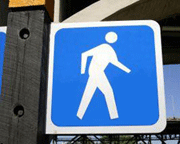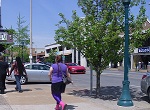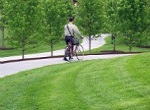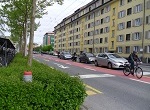Urban Sprawl and Public Health:
How They Are Related

Last Updated: July 9, 2025
The first time I heard about a link between urban sprawl and public health, I was skeptical. Basically I like the idea of individual responsibility for our health, except for something that is a clear public health issue, such as a contagious disease. How about you?
Experience suggested that my one-time obesity had more to do with love of desserts than whether I engaged in walking as transportation.
But the research shows that we exercise more when our community is walkable, and when physical activity is convenient. So sprawl and health are at least possibly related, even though living where there a dispersed development pattern (low residential density) obviously does not keep a motivated individual from seeking other exercise.
However, it is more and more clear that in the U.S. the healthcare system is headed for continuing tough times as we live longer and our technology turns out more and more expensive but very useful medical equipment and procedures.
Readers elsewhere may have different issues, but for U.S.
taxpayers, we need to cut our health risks drastically in every way we
can.
So in the spirit of pragmatism, we offer this piece about the connection between urban sprawl and public health. We would agree with the most careful researchers, among whom we count Reid Ewing, that sprawl or any development pattern is secondary to diet and exercise as a cause of obesity.
Although urban sprawl may not be the most important determinant of public health, that does not mean that the relationship is zero. The convenience factor of exercise is worth a second look.
When you can spend a few minutes or an hour on a walking trail or taking a bike ride, how does that change your life?
How Are Urban Sprawl and Public Health Related?
Let's see how urban sprawl might lead to health issues. There are five arguments that have merit, and we describe them below.
1. Urban sprawl leads to less exercise.
Two intertwined factors here are: (1) sprawl tends to lead to more driving instead of walking simply because distances to important destinations are greater, and (2) sprawling developments often are designed with cul-de-sacs and a curvilinear street pattern that makes a potential short walk into a long walk.
In large metro areas, highways may be almost essential for moving around the city effectively, and the ideal of a bikeable community may be elusive.
Urban sprawl may be so severe that biking to work isn't a feasible option, even if the frequent problems of lack of safe bicycle facilities and no shower at work are being addressed at many workplaces.
Another factor about exercise is that with longer commutes to the workplace, there's simply less time for exercise. Although the Covid-19 pandemic spurred plenty of working from home and working anywhere, our observation is that sedentary people continued to be sedentary. And certainly their weekend recreational trips might well include a long walk or cycling trip, but it is impractical to bike or walk as transportation if the only safe way to access the new Super Duper Museum is by highway.
So while we all can find ways around our barriers to exercise, research definitely shows that the more convenient the exercise regimen, the more likely it is to be followed. So urban sprawl and public health concerns are linked to the extent that fitness and obesity are part of the national interest in good health and the economic viability of the health care delivery system.
2. Urban sprawl and public health are related because the hectic lifestyle of driving everywhere promotes drive-through fast food usage.
The whole road-oriented and driving-centered culture makes the fast food drive-through lane seem to be the most natural convenience in the world.
While healthy choices can be located at most fast food joints with some poking around, it's tough to make that healthy decision when (a) the odor of what you want but shouldn't have is wafting not so gently on the breeze, and (b) you plan to eat while you're driving, which pretty well rules out a salad. So you ask yourself why not have fries instead. You rationalize that they will be easier to eat while driving.
3. Urban sprawl leads directly to the depopulation of the inner city and the inner ring suburbs, and leaves them as community poverty areas.
The consequence of trapping a permanent underclass in our central city, and even sometimes of gentrifying downtown with young people in their twenties, is that true grocery stores are in short supply in inner city neighborhoods and even in the lower-income inner suburbs.
And when there's no grocery store, probably the only nearby source of food is the local gas station or convenience store. What can you buy there? The likely choices include chips, cookies, ice cream, candy bars, soda, beer, cigarettes, doughnuts, and baloney.
To be fair, the food issue sometimes works the other way too. Certainly sprawling locations that attract the large superstores that include groceries may bring down the cost of good food. But that's hardly enough justification to atone for the abundance of junk food aimed at our inner cities and their children.
Think too of the mental health, substance abuse, and crime issues that proliferate where there is a concentration of poverty.
4. Urban sprawl and public health are related because of the air pollution issue.
Air pollution along our highways is a major proportion of the pollution in many cities today. And of course the more miles traveled, and the greater the percentage of driving that is of the high-polluting stop-and-go variety, the more severe this issue becomes.
If you work in the central city, you may have convinced yourself that this isn't a problem because you don't see pollution on a daily basis. However, spend a week in the country and see how your lungs feel.
If vehicle miles traveled can be decreased, cleaner fuels can be used for transportation, and a steadier pace can be maintained because we have a redundant grid-like system of roads, we'll have less air pollution.
5. Sprawl tends to produce a fair amount of traffic-induced stress and social isolation.
While certainly it is an exaggeration to say that large-lot subdivisions with attached garages and privacy fences produce isolation, these development patterns do mean that more intentionality is required to socialize with neighbors. The long commutes also tend toward isolation, since the majority of commuters in most metro areas are driving alone.
Long commutes also induce driving stress as things go wrong along the roadways. Again, we don't want to overplay this, since certainly you could be doing other stressful things if you are not commuting. However, traffic messes are not relaxing. And stress and detachment are bad for health.
Recommendations on Better Health Outcomes By Reducing Sprawl
In sum, we need to begin seriously addressing the walkability of our communities. We can do this through building new developments on new urbanism principles.
We can close downtown Interstate highways, as have Portland, Chattanooga, and other cities, and re-claim the historic street grid to funnel traffic through downtown just as quickly or even more efficiently. We can forbid cul-de-sacs and dead-end streets, which Virginia is considering. Even opening existing cul-de-sacs is possible as part of a suburban retrofit program.
We can insist that every major transit stop be graced by a transit-oriented development. We can reform our zoning ordinances and encourage mixed-use development.
Then we can find the fortitude to shut down the sprawl machine by building such attractive alternatives that the demand for housing away from the action falls dramatically.
The connection between urban sprawl and public health doesn't
look inevitable to me, but it's certainly helpful to society at this
point in our history to design towns and cities for successful health
outcomes.
More control of sprawl will produce the advantages of cleaner air, a closer-knit community, and better health, while also improving the visual attractiveness of the community through substituting green space for asphalt or concrete.
To get started on taking action about this important topic, you may want to check out the County Health Rankings for 2024, supported by the Robert Wood Johnson Foundation, the pre-eminent funder of public health initiatives in the U.S. Use that ranking to start a dialogue in your own community.
You also may want to see our answer to a site visitor's inquiry about the relationship of human health to the environment.
Learn More About Related Topics
- Making and Keeping a Good Community >
- Community Challenges, Common Topics & Concepts >
- Urban Sprawl > Urban Sprawl and Public Health
Join GOOD COMMUNITY PLUS, which provides you monthly with short features or tips about timely topics for neighborhoods, towns and cities, community organizations, and rural or small town environments. Unsubscribe any time. Give it a try.




